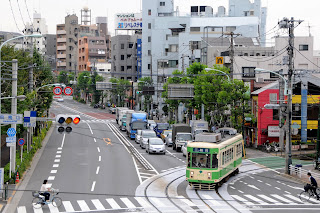 Recently re-opened after a three year renovation, the Nezu Museum is an incredible oasis within Tokyo. The industrialist and President of Tobu Railway, Kaichiro Nezu, originally opened this museum at his private residence in 1941. The museum and grounds cover more than 20,000 square meters. Within that space are the museum itself, a large Japanese garden, several tea houses, and a small cafe.
Recently re-opened after a three year renovation, the Nezu Museum is an incredible oasis within Tokyo. The industrialist and President of Tobu Railway, Kaichiro Nezu, originally opened this museum at his private residence in 1941. The museum and grounds cover more than 20,000 square meters. Within that space are the museum itself, a large Japanese garden, several tea houses, and a small cafe.The museum is divided into 6 galleries:
1) Special Exhibitions
2) Paintings and Calligraphy
3) Sculpture
4) Bronzes
5) Decorative Arts
6) Tea Arts
 The collection also includes lacquerware, bamboo crafts, ceramics, metalwork, textiles, and archaeological materials. Altogether the museum possesses over 7,000 pieces, including 7 works designated as National Treasures, 87 Important Cultural Properties, and 96 Important Art Objects. The museum's most famous pieces are its ancient Chinese bronzes and a folding screen of irises by the 17th century artist, Korin Ogata.
The collection also includes lacquerware, bamboo crafts, ceramics, metalwork, textiles, and archaeological materials. Altogether the museum possesses over 7,000 pieces, including 7 works designated as National Treasures, 87 Important Cultural Properties, and 96 Important Art Objects. The museum's most famous pieces are its ancient Chinese bronzes and a folding screen of irises by the 17th century artist, Korin Ogata.
 The collection also includes lacquerware, bamboo crafts, ceramics, metalwork, textiles, and archaeological materials. Altogether the museum possesses over 7,000 pieces, including 7 works designated as National Treasures, 87 Important Cultural Properties, and 96 Important Art Objects. The museum's most famous pieces are its ancient Chinese bronzes and a folding screen of irises by the 17th century artist, Korin Ogata.
The collection also includes lacquerware, bamboo crafts, ceramics, metalwork, textiles, and archaeological materials. Altogether the museum possesses over 7,000 pieces, including 7 works designated as National Treasures, 87 Important Cultural Properties, and 96 Important Art Objects. The museum's most famous pieces are its ancient Chinese bronzes and a folding screen of irises by the 17th century artist, Korin Ogata.The current special exhibition (11/18/09 - 12/23/09) is 'Nezu Seizan: Tea and Art'. Mr. Nezu was an enthusiastic practioner of tea ceremony and he was famous for his end of year 'tea parties' and his incredible collection of tea related artifacts.
All exhibits are labeled in English.
 This was my first visit to the Nezu Museum, and I was not disappointed. I was very impressed by the building itself, and its exhibits. But the garden took me completely by surprise. I have visited most of the gardens in Tokyo and this is now my very favorite. It is especially beautiful in the fall.
This was my first visit to the Nezu Museum, and I was not disappointed. I was very impressed by the building itself, and its exhibits. But the garden took me completely by surprise. I have visited most of the gardens in Tokyo and this is now my very favorite. It is especially beautiful in the fall. Unbelievably, it is just down the street from Aoyama-dori and Omotesando Station!
Unbelievably, it is just down the street from Aoyama-dori and Omotesando Station!Address: 6-5-1 Minami Aoyama, Minato-ku, Tokyo 107-0062
Getting there: 8 minute walk from exit A5 of Omotesando Station of the Ginza, Hanzomon, and Chiyoda subway lines. It is also 5 minutes from Minami Aoyama 6-chome Bus stop on the Metropolitan Bus Shibu 88 that runs between Shibuya and Shimbashi Stations.
Entrance fees: 1000 yen for regular collection, 1200 for special exhibitions
Hours of Operation: 10am - 5pm (last entry at 4:30). Closed on Mondays, during exhibition installations, and during the New Year's holiday period. When a National Holiday falls on a Monday, the museum is open on that Monday and is closed the next day.
Website: http://www.nezu-muse.or.jp/ *They have a fantastic English website, and the curator speaks perfect English.
I highly recommend this museum to anyone interested in Japanese culture, art, and gardens





 There are many observatories in Tokyo, but I like this one because Sangenjaya lies outside of the Yamanote Line and their are no other tall buildings nearby. It gives a very unique perspective of the city.
There are many observatories in Tokyo, but I like this one because Sangenjaya lies outside of the Yamanote Line and their are no other tall buildings nearby. It gives a very unique perspective of the city. The Setagaya Public Theatre is also located in the Carrot Tower. And, I am happy to say, they actually have an English website:
The Setagaya Public Theatre is also located in the Carrot Tower. And, I am happy to say, they actually have an English website: 

 Some interesting stations for explorations include:
Some interesting stations for explorations include: